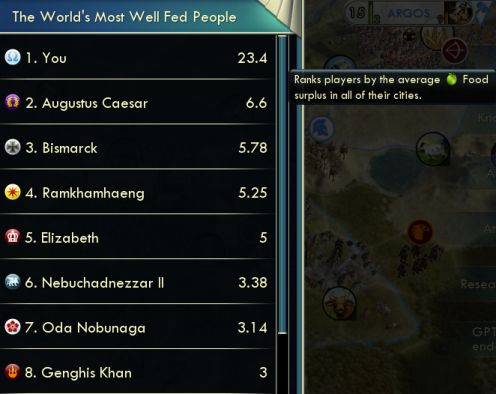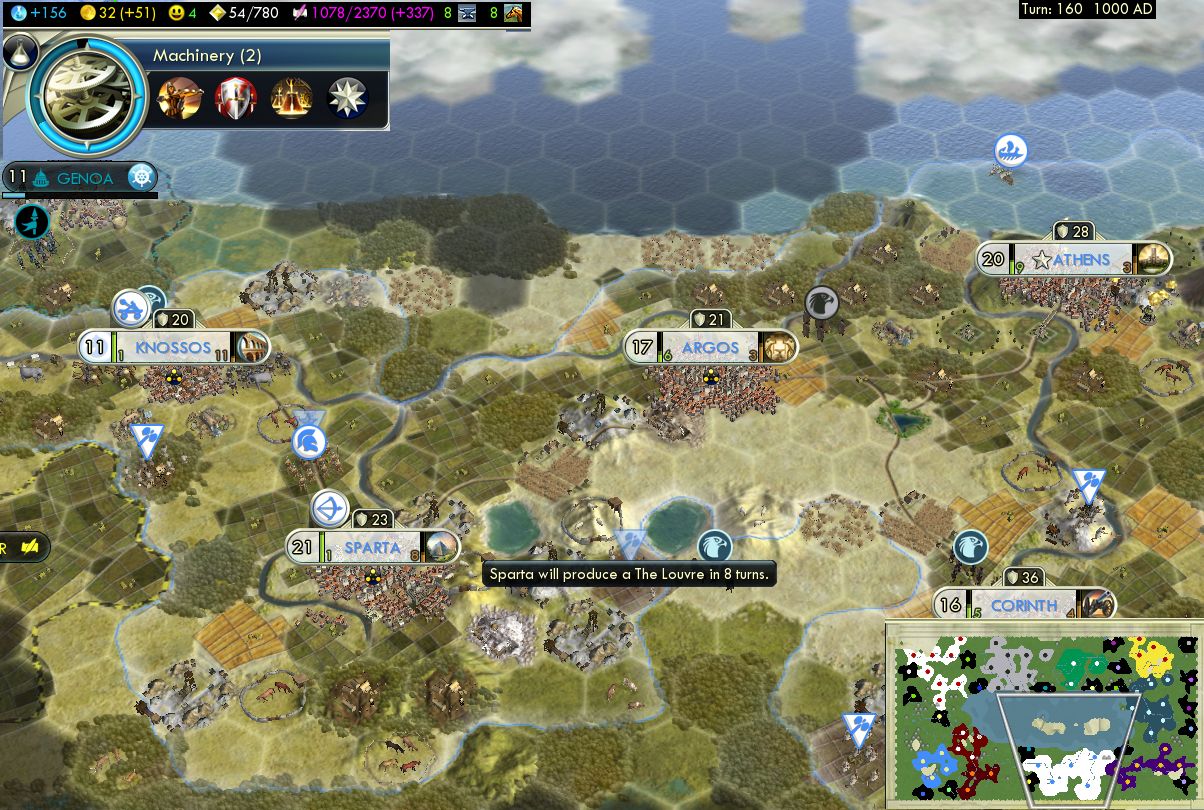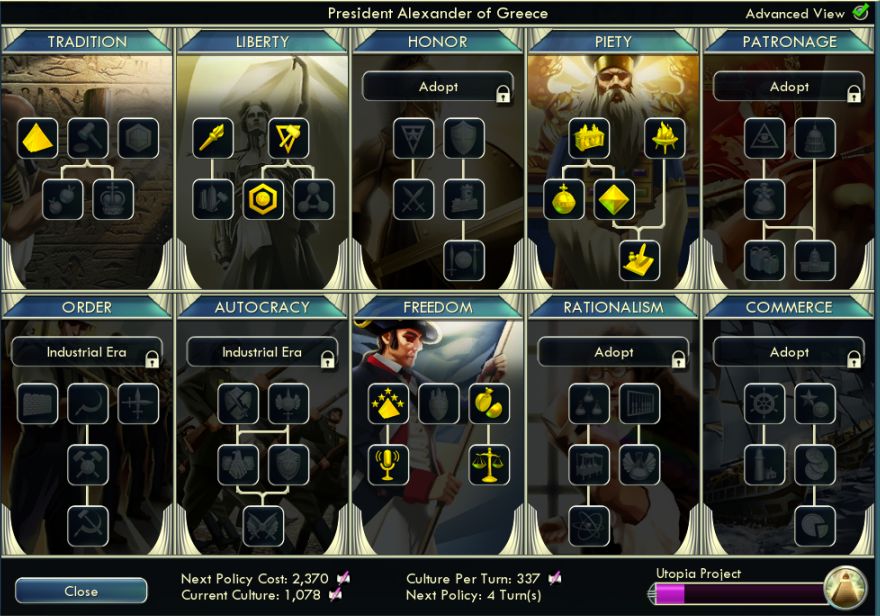
Here's an overview, showing the next two cities I founded, both on fertile rivers. Unfortunately Rome had beat me to the cotton area in the southeast. But I'm tied for the top of the scoreboard, with five city-states allied, and it's only going to snowball from here.

The Great Library sling to Civil Service got culture going seriously fast. Each of two allied city-states was now producing 12 culture which is almost as much as my entire civ's native production. That knocked through policies in 10 or fewer turns each, blasting through Piety in a hurry. Meanwhile, Sparta built the Hanging Gardens, always well worth its price, and of course the Oracle. I very much liked having two cities sharing the load of building the key wonders.
Hagia Sophia came next, on turn 103. With it, I now chained 45 straight turns of Golden Age. I sold luxuries to precisely manage happiness to delay the Golden Age until just after Hagia Sophia completed, and shortly added the Representation and Reformation policies for two more Golden Ages. As for the Hagia Sophia Great Person, I just took the Great Artist. There was a change in the June patch (at G&K release) that causes the HS free GP to bump up the Great Person cost counter, which makes it much less powerful. Given that, I don't think this GP slot can be spared for an engineer or scientist; you must have maximum artists.

So I had to build the Porcelain Tower the regular way, and had to do it in a hurry to bulb Acoustics with the scientist. (The PT scientist does NOT count towards the GPP cost counter, unlike Hagia. Weird.) I blasted through Piety very quickly, and needed to open the Renaissance for the Freedom tree by the time it was finished.
That overview also shows a fifth city I founded, Knossos. I don't know if this was a mistake. The main goal of the city was gold income; it's riverland and claims two ivory and a 6 iron source to sell. (Each iron sells for 45 gold over 30 turns; a 6-iron tile can be considered to produce 9 gpt. Each luxury is 8 gpt.) However, this city didn't have enough production to pull its weight. Ultimately I had to buy both the Opera House and Museum here, which kind of defeated the purpose of building a city for cash income. And of course it increased social policy costs, but it did eventually produce a Great Artist to recoup some or most of that. Honestly I still do not know whether this city speeded the culture victory or not.
One of few things that went wrong in this game came when I missed Machu Picchu. I'd forgotten about it since it didn't show up on the build list, because the city needs a peak in range AND IN YOUR BORDER. Of course a peak is a dead tile, so it never gets picked automatically, and costs a fortune to buy which would kind of defeat the purpose of building Machu Picchu in the first place. I swept most of the rest of the midgame wonders though, PT and ND and Sistine and Louvre and Big Ben and a bit later Taj Mahal.
Presently I got my one and only AI war declaration this game, from Napoleon to the west. French units couldn't even reach me with Mongolian territory in the way. About ten turns later a couple Frenchies washed up on the shore, which were promptly killed by the one cannon I'd built, and we signed peace.

Moving along with rapidity, here's another look at 1000 AD.

About now, I pulled focus off food. I started to convert hill farms and lumbermills to mines, and farms to trading posts. At size 20, growth costs 250 food, or 150 after the aqueduct, or 120 base food before WLTKD. So each +2 food farm (either grass or plains) takes 60 turns to add another citizen, an opportunity cost of 120 gold compared to the trading post that could have been on the tile. The new citizen is worth 1 gold by trade route and 1 beaker, plus he can work a trading post for 2 gold himself, for a total of 4 economy per turn. So this new citizen takes 30 more turns for a total of 90 until he catches up to the opportunity cost of the food it took to grow him. When the game end horizon is within 90 turns, stop working food tiles and convert to other productivity. Longer if you have to put in any effort for happy for the new citizen.

This shows the whole schedule of policy planning, which I'll detail here.
That's a bit more nuanced than the standard advice of "Liberty then Piety then Freedom", but I do think it's superior. The Liberty production and happy policies really are fairly marginal, so should wait. Piety must come early because the -10% policy cost finisher pays back for itself by the time you finish another tree. Next comes Freedom, whose finisher arrives just as the Landmark count is ramping up with the Louvre great artists. Patronage is worth doing sooner than last; Educated Elite is always worth at least a golden age if not more. Then finish the filler in Liberty and Tradition. These five trees are set in stone: Patronage always does more than Commerce, and all the other trees are blocked or useless (Honor).
I now know that's the optimal path for almost any culture victory. (Not that anyone cares about Civ 5 vanilla culture victories with the expansion now out.) In my France game, I tried completing Tradition early to get the food bonuses when they would matter, but that was the wrong approach. To get food, just buy city-states and build farms.